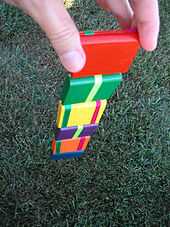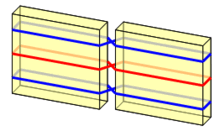Jacob's ladder (toy)

Watch toy in action (Ogg Theora format, 1.7 MB) (clip info)
A Jacob's ladder is a folk toy consisting of blocks of wood held together by strings or ribbons. The Jacob's Ladder folk toy, also known as 'tumbling blocks' dates back to the Pilgrim times in America. When the ladder is held at one end, blocks appear to cascade down the strings. However, this effect is a visual illusion which is the result of one block after another flipping over. Its name Jacob's Ladder comes from the biblical ladder to heaven, mentioned in Genesis 28:12. Because of the Biblical reference, Puritan children were allowed to use the Jacob's Ladder as a Sunday toy.
The earliest known review for the Jacob's Ladder is an 1889 Scientific American article which tells how it is built and works.[1] Despite urban myths prevalent on the internet, there is no known documentation dating it to Tutankhamun's tomb or ancient Egypt[2] or to the Pilgrims. It has been theorized that its origin is from a Chinese falling-block toy, called "Chinese blocks".[3]
The Japanese polymath Hiraga Gennai (1729–1779) constructed a Jacob's ladder which later came to be called "Gennai's Wondrous Click-clack" (Gennai no fushigina katakata, 源内の不思議なカタカタ).
Construction

An arrangement of interlaced ribbons allows each block to act as if hinged to the next one at either of its two ends. The same mechanism is used in the 1980s toy Rubik's Magic, but with plastic filaments run diagonally across squares, with the result that the squares can hinge along either of two adjacent sides.
References
- ↑ Scientific American, October 12, 1889, page 227.
- ↑ King Tutankhamun: The Treasures of the Tomb, by Zahi Hawass, a book detailing all the items found in the tomb and no listing matching that of a Jacob's Ladder toy.
- ↑ James G. Nourse, in his book "Simple Solutions to Rubik's Magic".